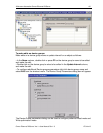
Klinkmann Automation Omron Ethernet DAServer 33
Omron Ethernet DAServer Ver 1.x User Manual Rev 1.3 17014m13
contains 8000 hex. In this case item name DM100 or DM100U would be displayed
in client as 32768. Signed quantities may be read from the same channel by
appending the suffix 'S' (or 's') to the item name. So, item name DM100S would be
displayed in client as -32768.
BCD Format
To read/write data using BCD format - append the suffix ‘B’ (or ‘b’) to the item
name, e.g. DM100B.
Long Format (Signed/BCD)
Two consecutive 16-bit words in a PLC can be interpreted as a 32-bit long integer.
It can be formatted as either signed (-2,147,483,648 to 2,147,483,648) or BCD (0
to 99,999,999). To read/write an item in signed long format - append the letter 'L'
(or 'l') to the item name. To read/write an item in BCD long format - append the
letter 'M' (or 'm') to the item name. For example, if DM100 contains 0234 hex and
DM101 contains 1356 hex, DM100L returns 324,403,764 and DM100M returns
13,560,234.
Note: Long format is not supported if Multiple Memory Area Read FINS commands
are used.
Floating Point Format (IEEE/BCD)
Two consecutive 16-bit words in a PLC can be interpreted as a single precision
floating point number. It is formatted as either IEEE (-3.402823 * 10
38
to 3.402823
* 10
38
) or BCD (0.0000001 * 10
-7
to 0.9999999 * 10
+7
). To read/write an item in
IEEE floating point format, append one of the following letters to the item name: 'F'
or 'f’. To read/write an item in BCD floating point format - append the letter 'G' (or
'g') to the item name. For example, if D100 contains 9620 hex and D101 contains
2436 hex in a CV500 PLC, D100F returns 3.959212 * 10-17 and D100G returns
0.4369620 * 102.
Floating point format is relevant only with items, indicating memory areas word
contents.
Note: IEEE format is NOT supported in the C-Series PLC family
Note: Floating point format is not supported if Multiple Memory Area Read FINS
commands are used.
ASCII Strings Format
Multiple consecutive 16-bit words (block size of 1 to 29) in a PLC can be
interpreted as a string of ASCII characters. The ASCII string is stored/retrieved
from the lowest-numbered address to the highest and from the high-order byte to
the low-order byte with each address. To define a range of words, use '-' (minus
sign) between the two address locations. For example, DM10-DM12 indicates
locations from DM10 to DM12. ASCII string characters can be specified to come
from the high-order byte, low-order byte, or both bytes of the words:
Low-order Byte Only the low-order byte (LSB - least significant 8-bits) of each
word is used for read. To use this format, append the suffix 'E'
to the item name.


















